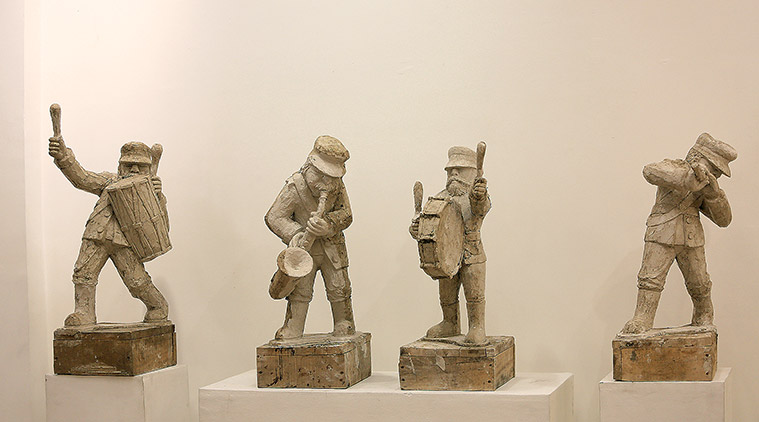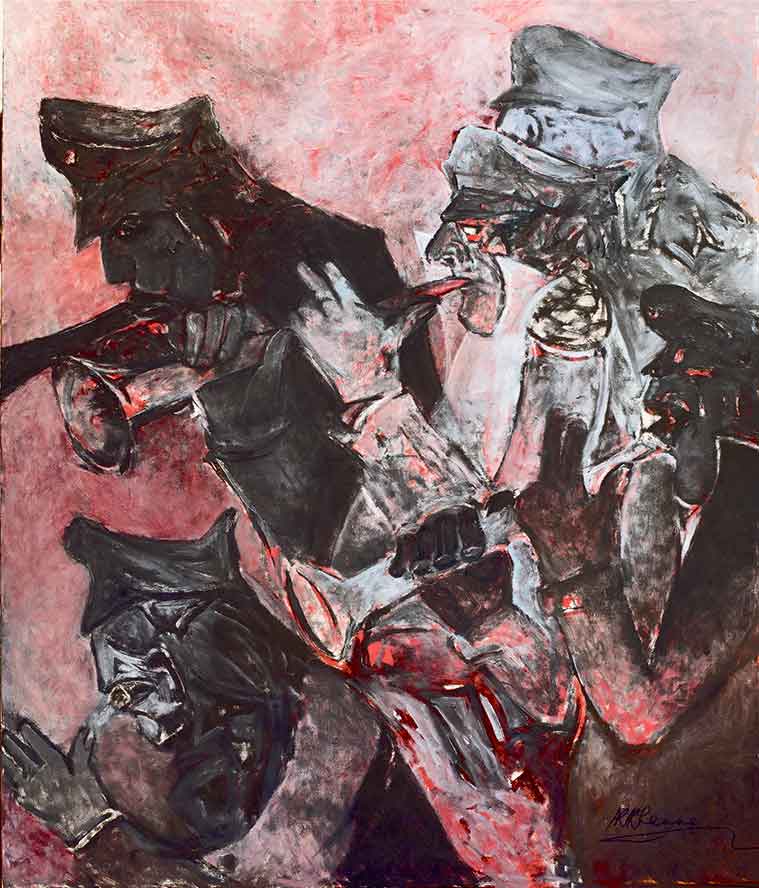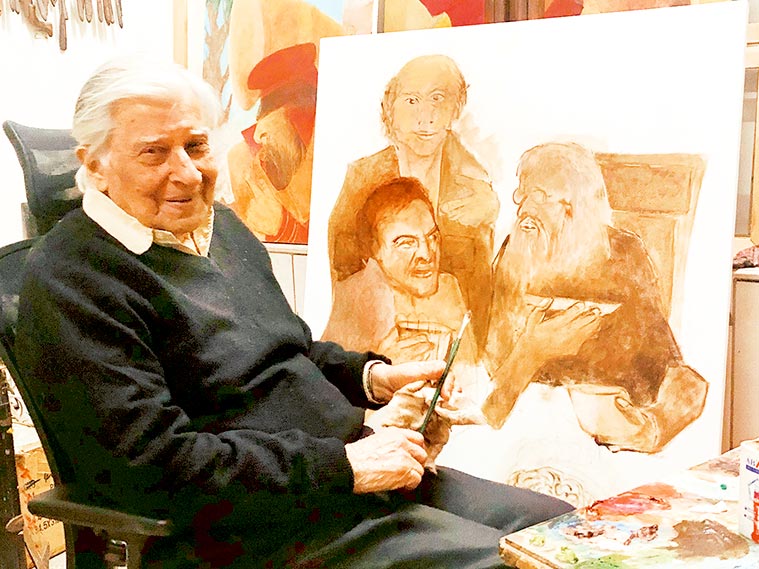 Last man standing: A series of bronze sculptures on bandwallahs from 2019. (Source: Gajendra Chauhan)
Last man standing: A series of bronze sculptures on bandwallahs from 2019. (Source: Gajendra Chauhan)
As Krishen Khanna leads you into his basement studio in Delhi, it is not the strong smell of colour or the bright canvases alone that strike you, but the artist’s grit and determination to “paint and paint some more.” “I am 95, I must use the remaining time as well as I can,” says one of India’s greatest modern painters.
To mark his 95th birthday last fortnight, his latest show at Artoholics Gallery in Delhi has 16 of his new paintings on display, along with some sculptures, all done in the past year. It’s a remarkable burst of productivity from an artist who has lived through a breadth of time and events. Even now, he paints at least five-and-a-half hours a day.
After the death of Akbar Padamsee last month, he is the last surviving member of the Progressives Artists Group, a landmark collective that shaped modern Indian art. One of his new works, In Memoriam, is a tribute to the camaraderie and influence of his colleagues. It shows his comrades-in-art, MF Husain, SH Raza, Bal Chhabda, Ram Kumar and VS Gaitonde, sipping tea, while being engages in a rapt discussion — something they did a lot of, when they were not painting.
 The Bandwallah (2019). (Courtesy Karan Khanna)
The Bandwallah (2019). (Courtesy Karan Khanna)
Khanna is a warm raconteur, who narrates slices of his remarkable and full life with cheer, ease — and always — context. At his age, he is conscious that he may slip up sometimes, so he makes notes when he must. He says he does not throw anything away, whether letters, papers or memories.
Born in Faisalabad, Punjab (now in Pakistan), in 1925, he left on a boat to England in the 1930s to “study at Kipling’s school”, the Imperial Service College, on a scholarship. Once World War II broke out, the boys received military training, too. He remembers the eventful journey back to India in 1942 “from around the Cape”. By the time they sailed back to Mumbai, all of their ship’s escort vehicles had been shot down.
He returned to Lahore, where his father was working. Asked to choose a classical language in school, he picked Persian, taught by “two Shia maulvis, the best teachers in the world. I remember their halimi (gentleness and wisdom) and the takhti (slate) and the ink.” The smell of ink followed him, even before he turned into a full-time painter, as he worked in a printing press at Government College, Lahore. “We made prints which involved lifting very heavy plates. It was also a very slow medium and I had to wait around a lot,” he recalls. It was time well spent as he lounged about in his shorts, reading Dylan Thomas.
Partition changed their lives forever, forcing them to leave Lahore. What followed was Khanna’s meeting with the boss at Grindlay’s Bank and his asking Khanna “if” he wanted a job. Khanna recalls telling him: “Perhaps, you would have noticed that there has been a Partition in India.” He landed the job and was posted in Mumbai, after an interview that effectively lasted five minutes.
 Krishen Khanna. (Source: Tashi Tobgyal)
Krishen Khanna. (Source: Tashi Tobgyal)
Khanna continued painting in his banking life, but it soon became impossible to reconcile the two. Finally, in 1961, urged by his friends Husain and Gaitonde, dramatically “standing outside the bank and urging him to hurry up and get out, while my shocked colleagues gave long-winded speeches at his farewell”, he left to pursue his passion fulltime. A branch of Grindlay’s in London later bought some of his paintings.
The decade of India’s Independence was one marked by deep political and social turmoil in the subcontinent. The Bengal famine and the massive migration in Bengal saw artists Chittaprosad and Somnath Hore draw attention to the misery of people. There was a general mood among several prominent artists to break away and locate a new modern Indian idiom.
The Progressive Artists Group is said to have started with a meeting on December 15, 1947 in Bombay, at which FN Souza, Raza and KH Ara decided to look for ways to challenge how paintings were judged for exhibitions, and evaluated. The group consisted originally of six artists (five painters and one sculptor). Author Mulk Raj Anand inaugurated their first show in Mumbai in 1949, which was a huge hit. He called them “heralds of a new dawn in the world of Indian art”.
The group tried to create an Indian form of modernism, and break away from the Bengal School of art. They emphatically acknowledged international influences, and were interested in an anti-imperialist, independent outlook, that could explore and acknowledge ordinary people and their lives. Khanna recalls the “free-flowing conversations most vividly. It was not hide-bound, we met frequently and we could discuss any work”.
At a time of great political and social ferment, the artists started by responding collectively and as Progressives, but soon each artist grew naturally into an individual style. Khanna was inducted to the group by Husain in 1950. Padamsee joined later.
The end of the empire was liberating for artists, too, Khanna recalls. He points out that the greatest tradition of miniatures in the Mughal court, was very “accomplished and skilled as it had to please the emperor! It had to be perfect.” But with democracy, artists were freer, art flowered as there was nobody to please.
Khanna’s history of being a migrant has always found its way on canvas, or shaped his sculptures. He insists he does not work according to themes, but the bandwallah has stayed with him, over many series, since he first started working on it in the 1980s. The bandwallah, a common sight in many north Indian towns, is the bearer of joy and cheer despite his own impoverished state — a thought that has led Khanna to return to the band in several works.
Biblical themes and motifs, too, return in different ways, for example, in his interpretation of The Last Supper. His niece, Gayatri Sinha, who has also collaborated on a book about his life and work in 2001, speaks of it being set at a roadside dhaba. “It elicits a complex cast of characters, in recognisable gestures of affirmation and betrayal. Cast also as artists and intellectuals from his own circle, the question of intellectual freedom takes on a much more compelling context,” she says.
Khanna is not interested in “auld lang syne” conversations for the sake of it, as he claims each day as his own, living it, painting and thinking, as much as someone half his age might do. He does remember art critics, his meetings and exchanges with John Berger, his own piece in an art magazine speaking out his mind on Souza. But he cannot forget his first encounter with Souza in the 1950s.
This was when he was strolling past Kala Ghoda in south Bombay and went up a winding staircase, where Souza was showing his work. On his way up, he encountered “two scandalised ladies running down whispering, ‘Very bad, very bad’.” Curious, he ran up faster and was immediately confronted by a large, nude self-portrait by Souza. “The police came by too after that. But Souza soon found an ingenious solution. He put patches on his works and covered up the naked paintings at strategic spots,” he says. The police is sometimes called in to examine art even today, but it is debatable if the patchwork would now serve as a way out.